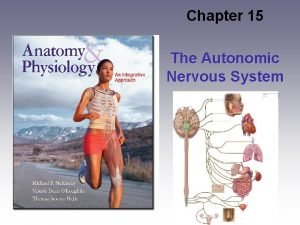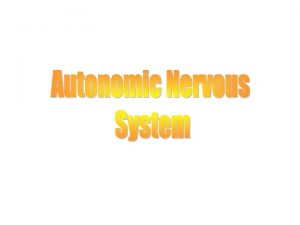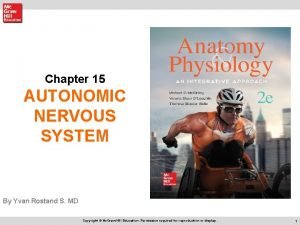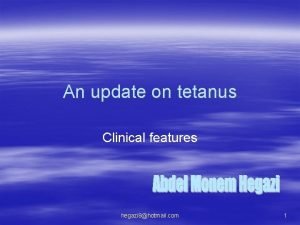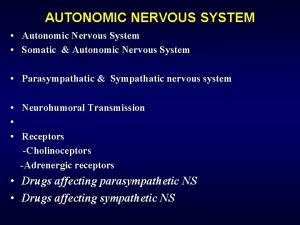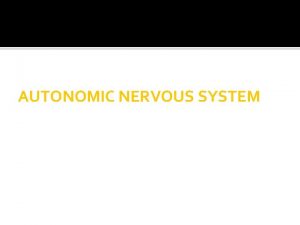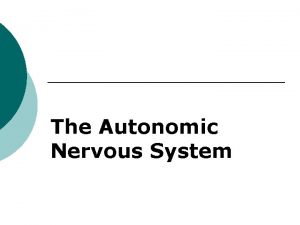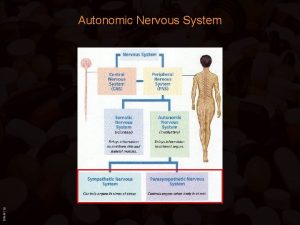AUTONOMIC NERVOUS SYSTEM Dr Maha Hegazi Professor of












- Slides: 12

AUTONOMIC NERVOUS SYSTEM Dr. Maha Hegazi Professor of Physiology Faculty of Medicine King Abdul Aziz University Lecture 5 MAHA HEGAZI 1

Functions of the parasympathetic nervous system: Objectives: By the end of this lecture the student should be able to: • List the characteristics of the parasym. System. • Describe the parasympathetic functions of different body organs. • List the higher centers that control the MAHA HEGAZI 2 ANS

Functions of the parasympathetic NS Parasympathetic NS is characterized by: • It discharges during rest and sleep. • Its action is localized. • It has anabolic action (conserve body stores ). • It increases gastrointestinal secretion & motility i. e. secretomotor. MAHA HEGAZI 3

MAHA HEGAZI 4

-3 rd cranial nerve (Occulomotor nerve): Eye: 1 -Pupil constriction (by contraction of the sphincter muscle of the iris. 2 -Accompdation of the eye to near vision due to contraction of the ciliarymuscle. -7 th cranial nerve (Facial nerve): Sublingual & sublingual salivary glands: Increases its secretion of watery saliva ( large volume). Lacrimal glands: increases its secretion of tears -9 th cranial nerve (Glossopharyngeal nerve): Parotid salivary glands: Increases its secretion of watery saliva ( large volume). MAHA HEGAZI 5

10 th Cranial nerve (X) vagus nerve (supply viscera in the thorax & abdomen) Thorax Heart Ooooooooooo Lung *Decrease heart rate. *Bronchoconstriction. *Decrease force of contraction of atria. *Increase mucous secretion from bronchial glands. *VC of coronary blood vessels indirectly due to decreased cardiac work and O 2 demand. MAHA HEGAZI 6

Abdominal Viscera *Gall bladder: Contraction of the wall & relaxation of the sphincter. *GIT: Contraction of the wall & relaxation of the sphincter (increase its secretion & motility). *Pancreas: Increase insulin secretion. MAHA HEGAZI 7

Sacral division ( supply the pelvic organs ): *Urinary bladder: Contraction of the wall and relaxation of the internal sphincter. Uterus: variable depending on the stage of the menstrual cycle, the estrogen and progesterone hormones, and pregnancy. *Rectum: Contraction of the wall and Relaxation of the internal sphincter. *External genitalia -Vasodilatation of the blood vessels - MAHA HEGAZI induce errection. 8

Dual innervation • Almost all visceral organs are supplied by both sympathetic and parasympathetic divisions of the autonomic NS. • Which division predominate at any given time is determined by the body demands at that time. • The parasympathetic discharge to the heart is more powerful at rest (vagal tone) While the sympathetic discharge to the blood vessles is more potent at rest (sympathetic tone. MAHA HEGAZI 9

Structures supplied only by sympathetic nervous system: • Skin • sweat glands sympathetic cholinergic) • Piloerector muscle. • blood vessels all over the body except the penis. • Dilator pupillae muscle. • Blood vessels of the skeletal muscles sympahetic • • cholinergic. Adrenal medulla. Capsule of the spleen. MAHA HEGAZI 10

Structures supplied only by Parasympathetic nervous system: • Constrictor pupillae muscle. MAHA HEGAZI 11

MAHA HEGAZI 12
 Ans
Ans Autonomic nervous system skeletal muscle
Autonomic nervous system skeletal muscle Autonomic nervous system consists of
Autonomic nervous system consists of Autonomic nervous system pathway
Autonomic nervous system pathway Visceral reflex
Visceral reflex Autonomic nervous system
Autonomic nervous system The autonomic nervous system controls
The autonomic nervous system controls Parasympathetic and sympathetic
Parasympathetic and sympathetic Autonomic nervous system
Autonomic nervous system Graphic organizer of nervous system
Graphic organizer of nervous system Inas hegazi
Inas hegazi Neuronal pool
Neuronal pool Nervous
Nervous





